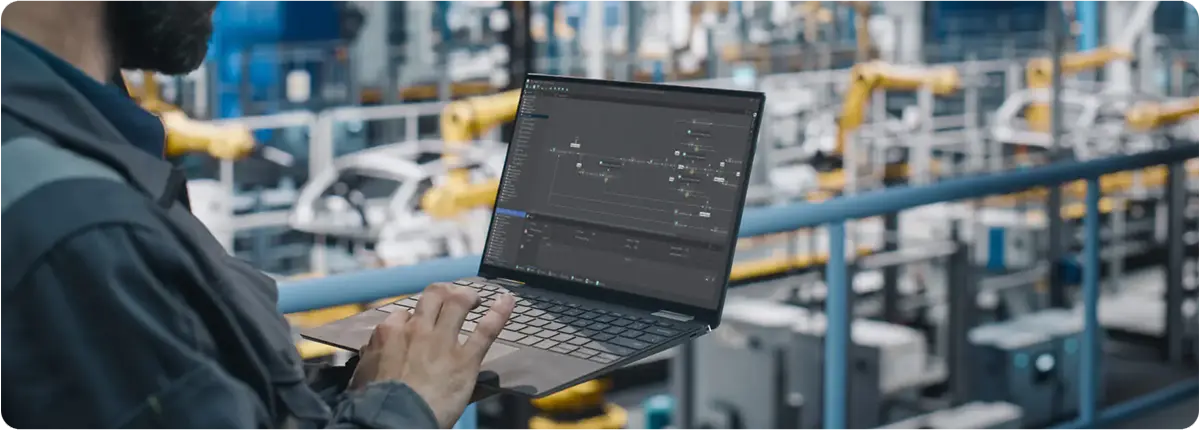Unlocking the full potential of predictive maintenance (PdM) in process industries requires information technology (IT) and operational technology (OT) to work seamlessly together. This article explains PdM’s business value, outlines three major IT/OT convergence challenges, and provides a practical roadmap to capture the right data and turn it into actionable insights.

WHY PREDICTIVE MAINTENANCE MATTERS
PdM continuously monitors equipment, analyzes real-time and historical data, and forecasts potential failures before they occur. This allows maintenance teams to schedule interventions during planned downtime, resulting in:
- Reduced unplanned downtime → improved Overall Equipment Effectiveness (OEE)
- Less wasted maintenance effort → focus on high-risk assets
- Optimized spare parts inventory → reduced working capital tied up in stock
In short, PdM enhances safety, productivity, and financial performance. But achieving this requires accurate, contextualized data—and that’s where IT/OT convergence becomes essential.
THREE CORE IT/OT CONVERGENCE CHALLENGES
Challenge 1 — Connecting Control Systems
Process plants operate a patchwork of heterogeneous systems: PLCs, DCS, SCADA, MES, historians, CMMS, and more.
- Proprietary and incompatible protocols (Modbus, Profibus/Profinet, EtherNet/IP, etc.)
- Air-gapped or segmented networks for cybersecurity
- Time synchronization and data timestamping issues (NTP/PTP)
Simply “plugging in a cable” doesn’t work. Secure, standards-based integration is required.
Challenge 2 — Capturing the Right Sensor Data
- Control system sampling rates may be adequate for process control but insufficient for PdM analytics.
- A pressure loop might sample at 1 Hz, while vibration analysis requires thousands of samples per second.
- Overloading the control network is risky; edge processing can collect, filter, and summarize high-frequency data before sending it to IT systems.
Challenge 3 — Accessing Historical and Maintenance Data
- Accurate predictions require combining real-time data + historical trends + maintenance records.
- Historians store process time-series data
- CMMS/EAM systems hold work orders, replaced components, and failure codes
Without integration, predictive models lack critical context.
DATA-FIRST ARCHITECTURE: TECHNOLOGY COMES SECOND
Successful PdM is not about installing technology first—it’s about designing around the right data. A practical roadmap includes:
Step 1 — Asset Audit and Goal Definition
- Critical asset inventory (pumps, compressors, control valves, motors, bearings)
- Risk and impact analysis (RPN, Pareto)
- Desired prediction horizon and early-warning thresholds
Step 2 — Standards-Based Integration
- Use OPC UA or MQTT for data exchange
- Follow ISA-95 for IT/OT hierarchy, IEC 62443 for security
- Implement synchronized timestamps via PTP/NTP
- Apply NAMUR Open Architecture (NOA) principles for secure data extraction
Step 3 — Edge Computing & Data Pipeline
- Protocol conversion, validation, and feature extraction at the edge
- On-device analytics to reduce noise (e.g., RMS, kurtosis, envelope detection)
- IT storage architecture with raw, curated, and feature data layers
Step 4 — Contextualization & Asset Modeling
- Hierarchical mapping: tag → equipment → line → unit → plant
- Asset models based on ISA-95/ISO 14224 to unify historian, CMMS, and live data
- Link availability, speed, and quality metrics (OEE) to each asset
Step 5 — Smart Sensor Strategy
- Data-rich: combine vibration, acoustic, temperature, and oil analysis
- Data-limited: use command/feedback signals (open/close time, actuator current) for anomaly detection
- Example: tracking increased open/close times on control valves to detect clogging or wear
Step 6 — Security and Governance
- Network segmentation, role-based access control, DMZ zones
- Data retention, model traceability, MLOps processes for drift detection
- Change management and user training
WHY “RIGHT DATA” IS EVERYTHING
PdM’s accuracy depends on the quality and relevance of the input data.
- Variety & context: Process, maintenance, and environmental data combined provide richer insights
- Accuracy & synchronization: Misaligned timestamps weaken correlations
- Continuity: New sensors need months to build a baseline; historian + CMMS context speeds this up
Goal: Extend prediction horizons from days to weeks for better resource planning.
APPLIED EXAMPLE: ANOMALY DETECTION ON CONTROL VALVES WITHOUT EXTRA SENSORS
- Edge monitoring tracked open/close cycle times, command-response delays, and failed cycles
- Gradual increases in cycle time indicated clogging or erosion
- Failure patterns informed a prioritized maintenance list
Result: no unplanned shutdowns due to valve clogging, despite zero additional instrumentation.
IMPLEMENTATION TIMELINE (90 DAYS → 12 MONTHS)
0–30 Days | Discovery & Architecture
- Asset mapping, data flow diagrams, security constraints
- Define KPIs: MTBF, MTTR, OEE, prediction accuracy
30–90 Days | Pilot & Validation
- Start with 1–2 asset families (pumps + control valves)
- Implement edge data collection and minimal feature set
- Validate early warning signals on the shop floor
3–6 Months | Scaling & Contextualization
- Integrate historian + CMMS, develop asset model
- Deploy dashboards and trigger work orders from PdM alerts
6–12 Months | Full Rollout & Optimization
- Expand to multiple production lines, manage models via MLOps
- Extend prediction horizons and track ROI
KEY METRICS & ROI TRACKING
- Unplanned downtime reduction (%)
- Early warning time (days/weeks)
- False alarm rate (%)
- Spare parts capital reduction (%)
- Shift in maintenance hours from reactive to proactive
Metrics should be reviewed monthly, and models/sensor strategies recalibrated accordingly.
8) COMMON PITFALLS TO AVOID
- Technology-first approach: Define business goals and data needs first
- Centralizing all raw data: Summarize and filter at the edge
- Ignoring cybersecurity: IEC 62443 compliance is essential
- Leaving CMMS out: Without work order integration, alerts stay passive
- Forgetting users: No PdM adoption without training and change management
CONCLUSION
Predictive maintenance in process manufacturing can extend asset life, reduce downtime, and enhance safety—but only if IT/OT convergence challenges are addressed methodically. Bridging the gaps in control system connectivity, high-quality sensor data, and historical/maintenance context with a data-first approach ensures PdM becomes a natural part of daily operations.
